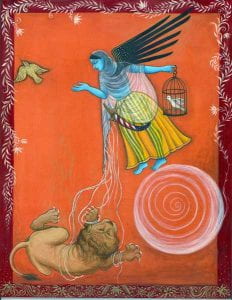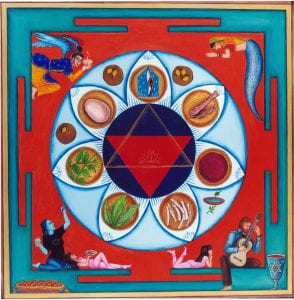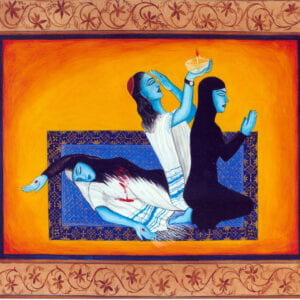 Centre College
Centre College
Steven A. Hoffman, Executive Director, Norton Center
Molly Baker, Engagement Services Manager, Norton Center
Shana Sippy, Assistant Professor of Religion
In June, 2021, Shana Sippy, Assistant Professor of Religion at Centre College, met with Centre College’s Norton Center for the Arts’ Engagement Services Manager, Molly Baker, and Executive Director, Steve Hoffman, to discuss an opportunity made possible by a grant from the Jewish Heritage Fund to enable us to bring an artist-in-residence to Centre College in Danville, KY. That discussion introduced Baker and Hoffman to the creative world of Siona Benjamin, whose work, as an Indian, Jewish, American, feminist artist, had always resonated in profound and personal ways for Sippy. What started as an idea to have Benjamin come to Centre to share her unique vision blossomed into a series of programs to engage our campus and community, and bring her work to the region more broadly. In addition to the art exhibition showcasing over two dozen of Siona’s powerful works on view at the Norton Center for the Arts between January and May, 2022, the campus will host a conversation between Benjamin and Haitian American artist Edouard Duval Carrié in February and a screening of Siona’s film Blue Like Me followed by a gallery talk with the artist while she is on campus in April, 2022. The commitment to present this exhibition led to a tour of the show to three other venues, with whom we have had the privilege to partner over these past few months. During this exhibition, not only will Centre students and community members from central Kentucky be able to study and experience these works, they will have the opportunity to engage directly with Benjamin. In addition, over the course of the exhibition, patrons attending performances, ranging from Irish dancers to Broadway musicals and from jazz ensembles to classical cellist Yo-Yo Ma, will be drawn into this exhibition of Siona Benjamin’s work, offering them the chance to consider how her perspective on the world reflects or differs from their own. Throughout the spring, students will be adding to this exhibition, bringing their insights, research, experiences, and questions into conversation with Benjamin’s work and inviting others to do the same.
 Jewish Museum Milwaukee, Milwaukee, WI
Jewish Museum Milwaukee, Milwaukee, WI
Molly Dubin, Curator
It’s hard to believe that it’s been over twenty years since I first became acquainted with Siona. At the time I was immediately struck by the beauty and vibrancy of her work, and the more I learned about Siona and her unique background, the more enthralled I became. Much has transpired between then and now, but topics at the forefront of global discourse, many with centuries, if not millennia long roots, remain. Bridging the past to the present, exploring parallels to contemporary events and addressing social justice issues are central to Jewish Museum Milwaukee’s mission. Projects that combine history, culture, religion and art are incredibly impactful because they enable us to approach concepts from multiple and diverse perspectives. Art is a barrier transcending agent which has the universal ability to effect perception and change, and Siona’s pieces masterfully intertwine her transcultural background and experiences to illustrate an inner dialogue she is having about identity and belonging and one she is having with the viewer, potentially challenging the criteria of their conclusions. Collectively we have all been challenged by the events and circumstances of these past few pandemic years, so it is meaningful and inspiring on many levels to have the opportunity to work with Siona at this juncture. JMM is a place ‘Where Conversations Happen’ and Siona’s work is a powerful catalyst.
The Galleries at CSU, Cleveland State University, Cleveland, OH 
Samantha Baskind, Professor of Art History
Five years ago I was tasked with writing an essay for an edited volume on images of Queen Esther in American art through a social, political, religious, and cultural lens. It was then that I stumbled on the most unique of all the works I discovered: Siona Benjamin’s highly ornate, 15-foot long, illuminated scroll of Esther that approximates the tradition of Indian-Persian miniatures. I surely knew of Siona’s art before I viewed the striking megillah but I was even more intrigued and actively sought her out. Learning about Siona’s vast body of work on a variety of crucial and often intersecting contemporary themes—women’s rights, immigration, global politics, and race, all through a Jewish lens—convinced me that an exhibition of her art at The Galleries at CSU would enrich our diverse student body and the larger Cleveland community. The exhibition purposefully coincides with Women’s History Month, when Siona will be on campus to give a series of lectures. During the duration of the show, I am teaching a “Modern Jewish Art and Culture” seminar, and my students will work on projects in conjunction with the exhibition. So too, CSU’s dance majors are planning a performance inspired by the show. I look forward to the vital conversations that will arise across our university and even just the visual pleasure this exhibition will bring to thousands of visitors to our gallery, who will be viewing Siona’s transcultural, gorgeously rendered, tremendously powerful work for the first time.
Skirball Museum of Hebrew Union College-Jewish Institute of Religion, Cincinnati, OH
Abby Schwartz, Director
It was during the early months of COVID-19 that I logged onto a webinar about contemporary Jewish women artists and heard and saw Siona Benjamin for the first time. Her work was somewhat familiar to me, but I became a true believer when I witnessed her passion and creativity that dark April day in 2020. When the opportunity arose to bring Beyond Borders: The Art of Siona Benjamin to the Skirball Museum on the historic Cincinnati campus of Hebrew Union College-Jewish Institute of Religion (HUC-JIR), I jumped at the chance to display this important body of work. It is a meaningful exhibition for the Skirball and HUC-JIR on so many levels. Rabbi Sally Priesand, the first American woman rabbi in America, was ordained at HUC-JIR in 1972. Like Siona Benjamin, Rabbi Priesand shattered glass ceilings and crossed borders to achieve her goals. The Skirball is the only museum of Jewish art, culture, and history in Cincinnati, and sits proudly on a college campus that is home to a seminary for the Reform rabbinate as well as the Pines School of Graduate Studies that promotes academic Jewish studies in an interfaith American context. The HUC-JIR campus is also home to the renowned Klau Library, which, in quantity and quality of holdings, stands at or near the top of all American collections of Hebraica and among the strongest in the world. Siona Benjamin writes: “While I am a Jewish artist, my perspective remains transcultural and multicultural at heart. I combine the imagery of my past with the role I play in America today, making a mosaic inspired by illuminated manuscripts and multicultural mythology.” I couldn’t imagine a better setting than the Skirball Museum to explore the themes of gender, race, identity, and home that resonate in Siona’s work. Our campus community and larger secular audience are sure to be inspired by this remarkable exhibition.